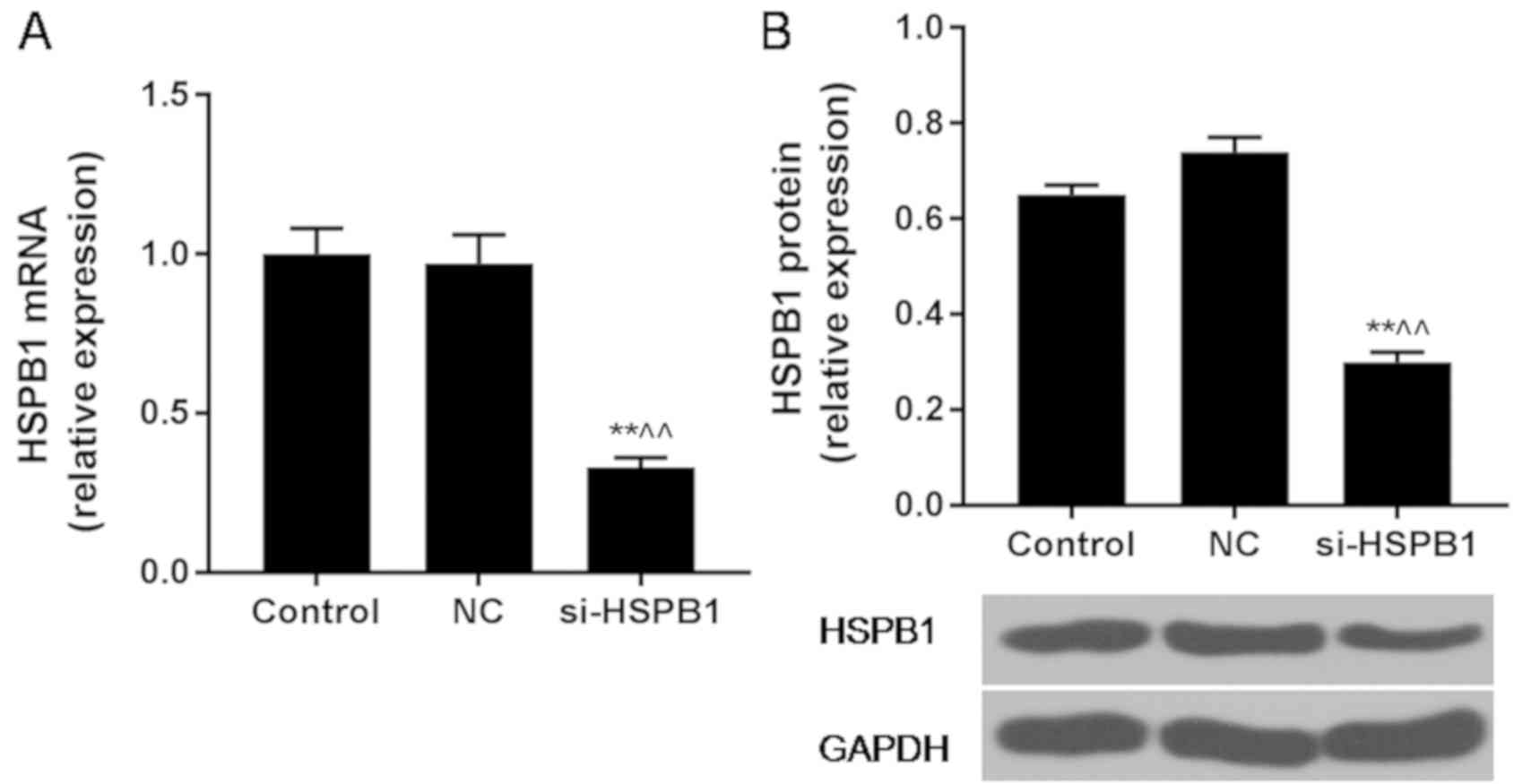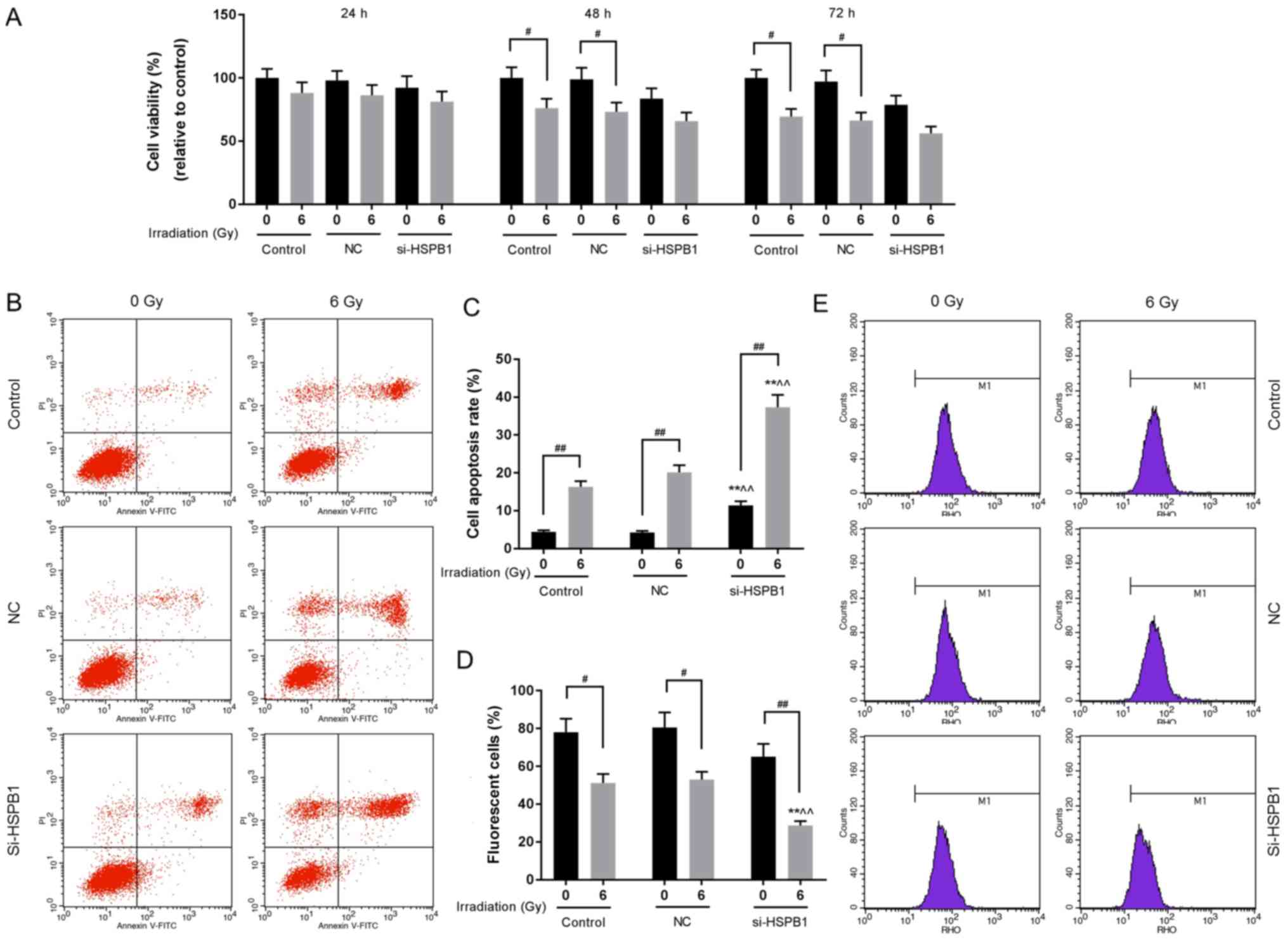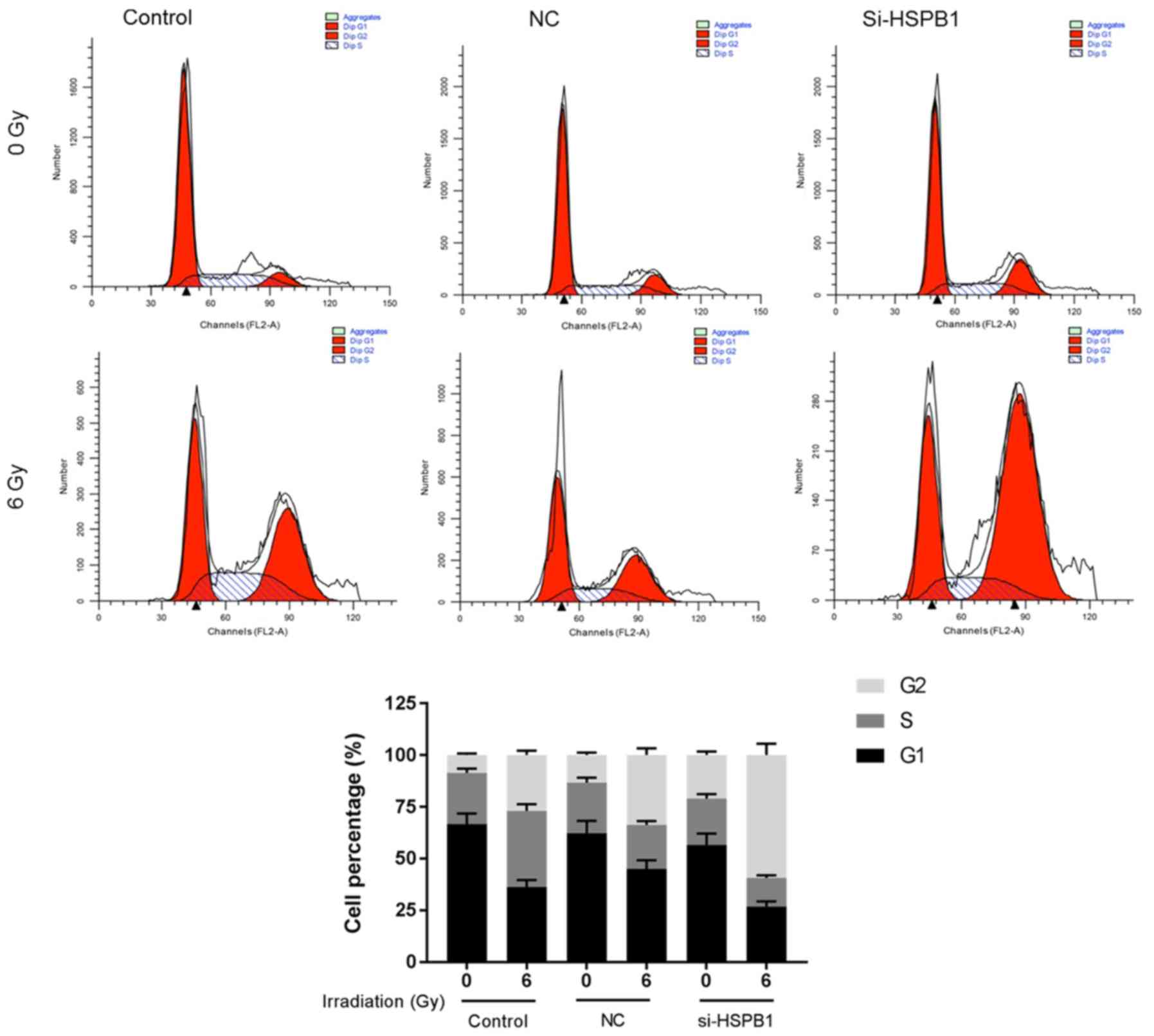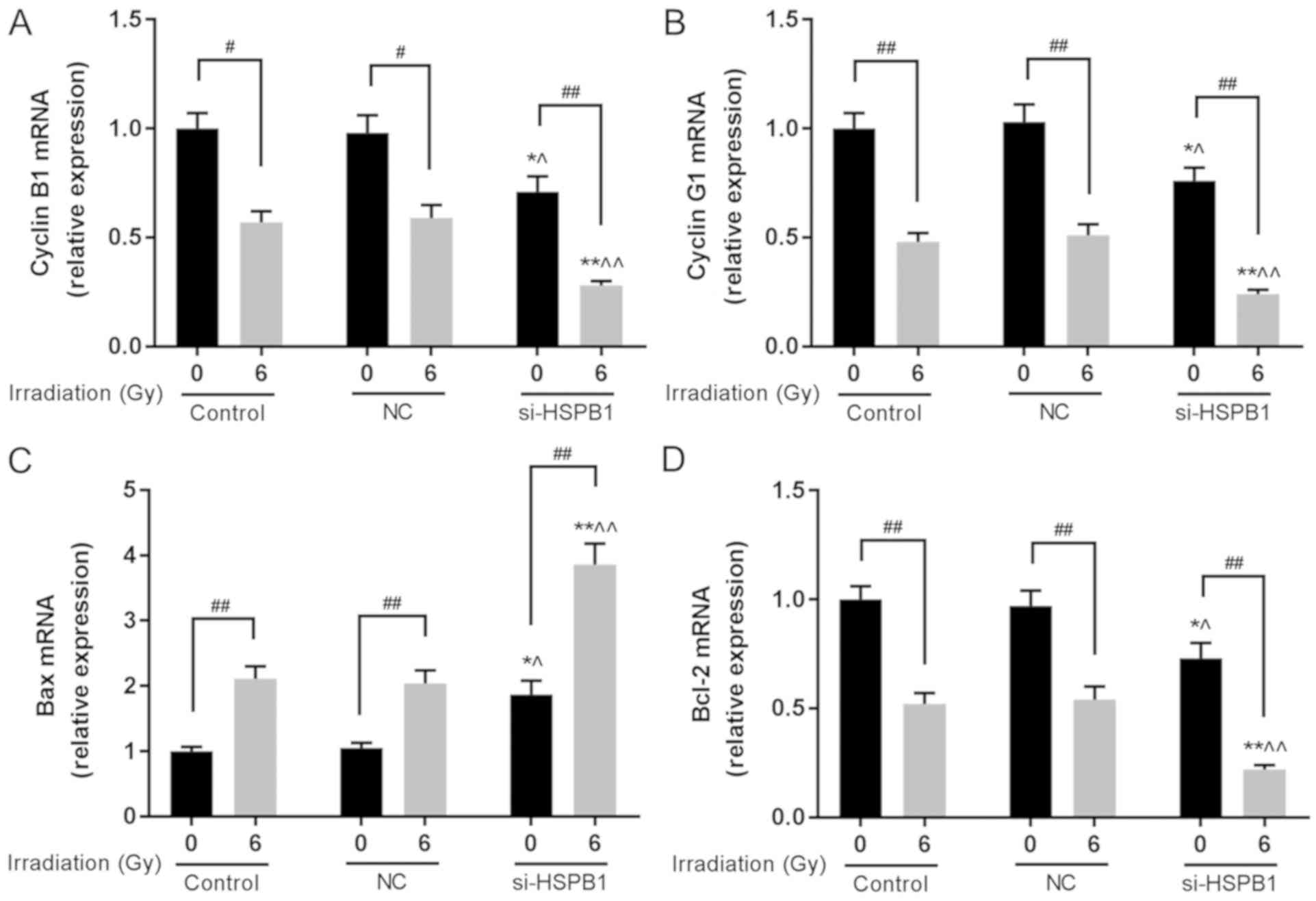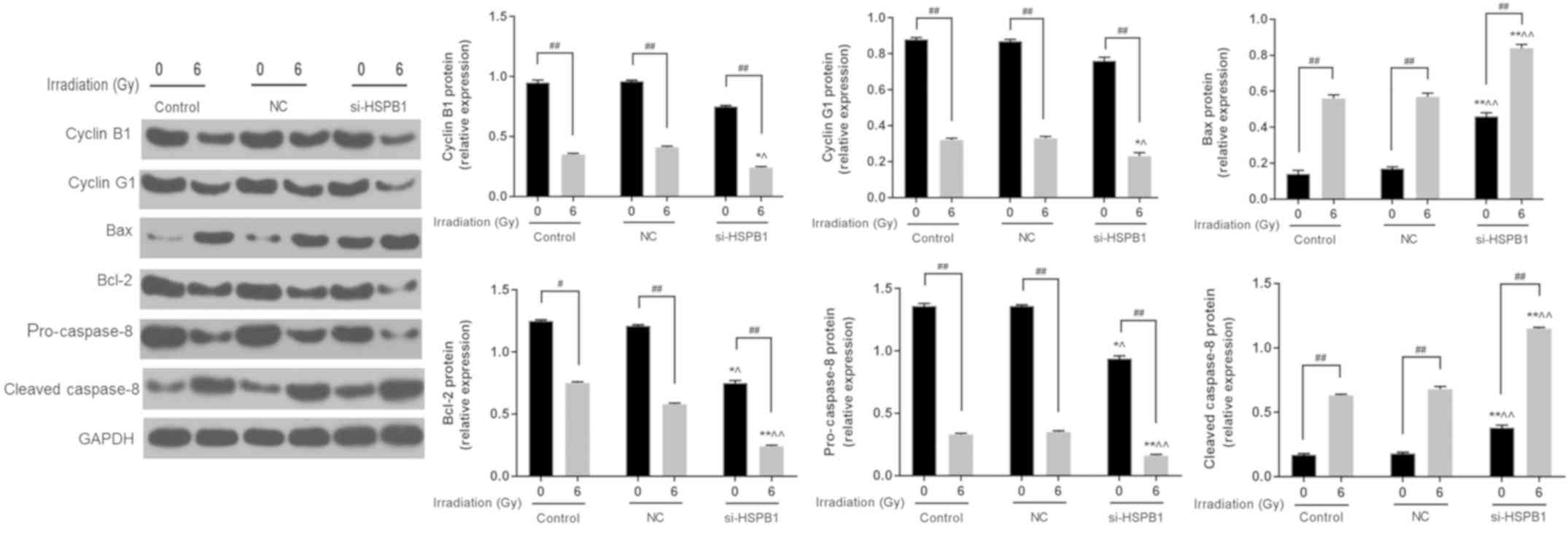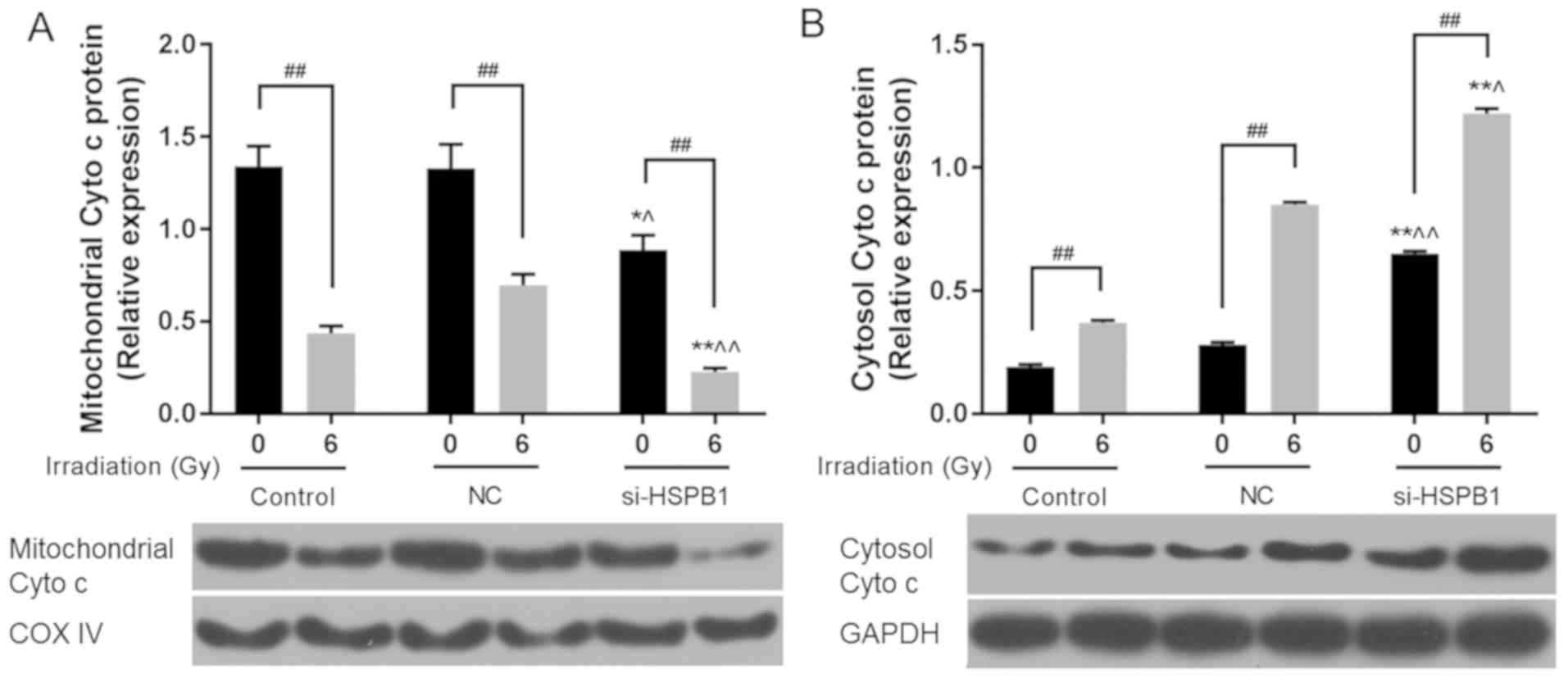|
1
|
Siegel R, Ma J, Zou Z and Jemal A: Cancer
statistics, 2014. CA Cancer J Clin. 64:9–29. 2014. View Article : Google Scholar : PubMed/NCBI
|
|
2
|
Jemal A, Siegel R, Xu J and Ward E: Cancer
statistics, 2010. CA Cancer J Clin. 60:277–300. 2010. View Article : Google Scholar : PubMed/NCBI
|
|
3
|
Ellis PM and Vandermeer R: Delays in the
diagnosis of lung cancer. J Thorac Dis. 3:183–188. 2011.PubMed/NCBI
|
|
4
|
Benveniste MF, Welsh J, Godoy MC,
Betancourt SL, Mawlawi OR and Munden RF: New era of radiotherapy:
An update in radiation-induced lung disease. Clin Radiol.
68:e275–e290. 2013. View Article : Google Scholar : PubMed/NCBI
|
|
5
|
Fox W and Scadding JG: Medical research
council comparative trial of surgery and radiotherapy for primary
treatment of small-celled or oat-celled carcinoma of bronchus.
Ten-year follow-up. Lancet. 2:63–65. 1973. View Article : Google Scholar : PubMed/NCBI
|
|
6
|
Changizi V, Bahrami M, Esfahani M and
Shetab-Boushehri SV: Prevention of γ-radiation-induced DNA damage
in human lymphocytes using a serine-magnesium sulfate mixture.
Sultan Qaboos Univ Med J. 17:e162–e167. 2017.PubMed/NCBI
|
|
7
|
Triggiani L, Colosini A, Buglione M,
Pasinetti N, Orizio F, Bardoscia L, Borghetti P, Maddalo M, Spiazzi
L, Magrini SM and Bresciani R: Exploring the role of enzalutamide
in combination with radiation therapy: An in vitro study.
Anticancer Res. 38:3487–3492. 2018. View Article : Google Scholar : PubMed/NCBI
|
|
8
|
Murad H, Alghamian Y, Aljapawe A and
Madania A: Effects of ionizing radiation on the viability and
proliferative behavior of the human glioblastoma T98G cell line.
BMC Res Notes. 11:3302018. View Article : Google Scholar : PubMed/NCBI
|
|
9
|
Kased N, Erasmus JJ, Komaki R and Cox JD:
Prognostic value of posttreatment [18F] fluorodeoxyglucose uptake
of primary non-small cell lung carcinoma treated with radiation
therapy with or without chemotherapy: A brief review. J Thorac
Oncol. 3:534–538. 2008. View Article : Google Scholar : PubMed/NCBI
|
|
10
|
Nagata Y and Kimura T: Stereotactic body
radiotherapy (SBRT) for stage I lung cancer. Jpn J Clin Oncol.
48:405–409. 2018. View Article : Google Scholar : PubMed/NCBI
|
|
11
|
Skrzypski M and Jassem J: Consolidation
systemic treatment after radiochemotherapy for unresectable stage
III non-small cell lung cancer. Cancer Treat Rev. 66:114–121. 2018.
View Article : Google Scholar : PubMed/NCBI
|
|
12
|
Deniset JF and Pierce GN: Heat shock
proteins: Mediators of atherosclerotic development. Curr Drug
Targets. 16:816–826. 2015. View Article : Google Scholar : PubMed/NCBI
|
|
13
|
Zhang L, Fok JH and Davies FE: Heat shock
proteins in multiple myeloma. Oncotarget. 5:1132–1148. 2014.
View Article : Google Scholar : PubMed/NCBI
|
|
14
|
Albany C and Hahn NM: Heat shock and other
apoptosis-related proteins as therapeutic targets in prostate
cancer. Asian J Androl. 16:359–363. 2014. View Article : Google Scholar : PubMed/NCBI
|
|
15
|
Choi B, Choi SK, Park YN, Kwak SY, Lee HJ,
Kwon Y, Na Y and Lee YS: Sensitization of lung cancer cells by
altered dimerization of HSP27. Oncotarget. 8:105372–105382. 2017.
View Article : Google Scholar : PubMed/NCBI
|
|
16
|
McConnell JR and McAlpine SR: Heat shock
proteins 27, 40, and 70 as combinational and dual therapeutic
cancer targets. Bioorg Med Chem Lett. 23:1923–1928. 2013.
View Article : Google Scholar : PubMed/NCBI
|
|
17
|
Huang Z, Yang C, Sun S, Nan Y, Lang Z,
Wang X, Zhao J and Liu Y: Heat shock protein 27, a novel regulator
of transforming growth factor β induced resistance to cisplatin in
A549 cell. Pharmacology. 100:283–291. 2017. View Article : Google Scholar : PubMed/NCBI
|
|
18
|
Stope MB, Weiss M, Preuss M, Streitbörger
A, Ritter CA, Zimmermann U, Walther R and Burchardt M: Immediate
and transient phosphorylation of the heat shock protein 27
initiates chemoresistance in prostate cancer cells. Oncol Rep.
32:2380–2386. 2014. View Article : Google Scholar : PubMed/NCBI
|
|
19
|
Zhang Y, Tao X, Jin G, Jin H, Wang N, Hu
F, Luo Q, Shu H, Zhao F, Yao M, et al: A targetable molecular
chaperone Hsp27 confers aggressiveness in hepatocellular carcinoma.
Theranostics. 6:558–570. 2016. View Article : Google Scholar : PubMed/NCBI
|
|
20
|
Zhao GY, Ding JY, Lu CL, Lin ZW and Guo J:
The overexpression of 14-3-3ζ and Hsp27 promotes non-small cell
lung cancer progression. Cancer. 120:652–663. 2014. View Article : Google Scholar : PubMed/NCBI
|
|
21
|
Zhang B, Qu JQ, Xiao L, Yi H, Zhang PF, Li
MY, Hu R, Wan XX, He QY, Li JH, et al: Identification of heat shock
protein 27 as a radioresistance-related protein in nasopharyngeal
carcinoma cells. J Cancer Res Clin Oncol. 138:2117–2125. 2012.
View Article : Google Scholar : PubMed/NCBI
|
|
22
|
Livak KJ and Schmittgen TD: Analysis of
relative gene expression data using real-time quantitative PCR and
the 2(-Delta Delta C(T)) method. Methods. 25:402–408. 2001.
View Article : Google Scholar : PubMed/NCBI
|
|
23
|
Bernardi P, Rasola A, Forte M and Lippe G:
The mitochondrial permeability transition pore: Channel formation
by F-ATP synthase, integration in signal transduction, and role in
pathophysiology. Physiol Rev. 95:1111–1155. 2015. View Article : Google Scholar : PubMed/NCBI
|
|
24
|
Chen X, Wang P, Guo F, Wang X, Wang J, Xu
J, Yuan D, Zhang J and Shao C: Autophagy enhanced the
radioresistance of non-small cell lung cancer by regulating ROS
level under hypoxia condition. Int J Radiat Biol. 93:764–770. 2017.
View Article : Google Scholar : PubMed/NCBI
|
|
25
|
Saitoh JI, Shirai K, Abe T, Kubo N, Ebara
T, Ohno T, Minato K, Saito R, Yamada M and Nakano T; Working Group
of The Lung Tumor, : A phase I study of hypofractionated Carbon-ion
radiotherapy for stage III Non-small cell lung cancer. Anticancer
Res. 38:885–891. 2018.PubMed/NCBI
|
|
26
|
Song Y, Zuo Y, Qian XL, Chen ZP, Wang SK,
Song L and Peng LP: Inhibition of MicroRNA-21-5p promotes the
radiation sensitivity of non-small cell lung cancer through HMSH2.
Cell Physiol Biochem. 43:1258–1272. 2017. View Article : Google Scholar : PubMed/NCBI
|
|
27
|
Carmichael J, Degraff WG, Gamson J, Russo
D, Gazdar AF, Levitt ML, Minna JD and Mitchell JB: Radiation
sensitivity of human lung cancer cell lines. Eur J Cancer Clin
Oncol. 25:527–534. 1989. View Article : Google Scholar : PubMed/NCBI
|
|
28
|
Guttmann DM, Hart L, Du K, Seletsky A and
Koumenis C: Inhibition of Hsp27 radiosensitizes head-and-neck
cancer by modulating deoxyribonucleic acid repair. Int J Radiat
Oncol Biol Phys. 87:168–175. 2013. View Article : Google Scholar : PubMed/NCBI
|
|
29
|
Kimura K, Bowen C, Spiegel S and Gelmann
EP: Tumor necrosis factor-alpha sensitizes prostate cancer cells to
gamma-irradiation- induced apoptosis. Cancer Res. 59:1606–1614.
1999.PubMed/NCBI
|
|
30
|
Ly JD, Grubb DR and Lawen A: The
mitochondrial membrane potential (deltapsi(m)) in apoptosis; An
update. Apoptosis. 8:115–128. 2003. View Article : Google Scholar : PubMed/NCBI
|
|
31
|
Dittmann KH, Rothmund MC, Paasch A, Mayer
C, Fehrenbacher B, Schaller M, Frauenstein K, Fritsche E,
Haarmann-Stemmann T, Braeuning A and Rodemann HP: The nuclear aryl
hydocarbon receptor is involved in regulation of DNA repair and
cell survival following treatment with ionizing radiation. Toxicol
Lett. 240:122–129. 2016. View Article : Google Scholar : PubMed/NCBI
|
|
32
|
Raviraj J, Bokkasam VK, Kumar VS, Reddy US
and Suman V: Radiosensitizers, radioprotectors, and radiation
mitigators. Indian J Dent Res. 25:83–90. 2014. View Article : Google Scholar : PubMed/NCBI
|
|
33
|
Saleh EM: Inhibition of topoisomerase IIα
sensitizes FaDu cells to ionizing radiation by diminishing DNA
repair. Tumour Biol. 36:8985–8992. 2015. View Article : Google Scholar : PubMed/NCBI
|
|
34
|
Medema RH and Macurek L: Checkpoint
control and cancer. Oncogene. 31:2601–2613. 2012. View Article : Google Scholar : PubMed/NCBI
|
|
35
|
Adeberg S, Bernhardt D, Harrabi SB,
Nicolay NH, Hörner-Rieber J, König L, Repka M, Mohr A, Abdollahi A,
Weber KJ, et al: Metformin enhanced in vitro radiosensitivity
associates with G2/M cell cycle arrest and elevated
Adenosine-5′-monophosphate-activated protein Kinase levels in
glioblastoma. Radiol Oncol. 51:431–437. 2017. View Article : Google Scholar : PubMed/NCBI
|
|
36
|
Lesueur P, Chevalier F, El-Habr EA, Junier
MP, Chneiweiss H, Castera L, Müller E, Stefan D and Saintigny Y:
Radiosensitization effect of talazoparib, a parp inhibitor, on
glioblastoma stem cells exposed to low and high linear energy
transfer radiation. Sci Rep. 8:36642018. View Article : Google Scholar : PubMed/NCBI
|
|
37
|
Luo H, Xi Y, Li W, Li J, Li Y, Dong S,
Peng L, Liu Y and Yu W: Cell identity bookmarking through
heterogeneous chromatin landscape maintenance during the cell
cycle. Hum Mol Genet. 26:4231–4243. 2017. View Article : Google Scholar : PubMed/NCBI
|
|
38
|
Wang L, Xia Y, Chen T, Zeng Y, Li L, Hou
Y, Li W and Liu Z: Sanyang Xuedai enhances the radiosensitivity of
human non-small cell lung cancer cells via increasing iNOS/NO
production. Biomed Pharmacother. 102:618–625. 2018. View Article : Google Scholar : PubMed/NCBI
|
|
39
|
Wang Y, Hu L, Zhang X, Zhao H, Xu H, Wei
Y, Jiang H, Xie C, Zhou Y and Zhou F: Downregulation of
mitochondrial single stranded DNA binding protein (SSBP1) induces
mitochondrial dysfunction and increases the radiosensitivity in
non-small cell lung cancer cells. J Cancer. 8:1400–1409. 2017.
View Article : Google Scholar : PubMed/NCBI
|
|
40
|
Zhan N, Li B, Xu X, Xu J and Hu S:
Inhibition of FASN expression enhances radiosensitivity in human
non-small cell lung cancer. Oncol Lett. 15:4578–4584.
2018.PubMed/NCBI
|
|
41
|
Zhao Y, Jiang W, Li B, Yao Q, Dong J, Cen
Y, Pan X, Li J, Zheng J, Pang X and Zhou H: Artesunate enhances
radiosensitivity of human non-small cell lung cancer A549 cells via
increasing NO production to induce cell cycle arrest at G2/M phase.
Int Immunopharmacol. 11:2039–2046. 2011. View Article : Google Scholar : PubMed/NCBI
|
|
42
|
Sun X, Zhangyuan G, Shi L, Wang Y, Sun B
and Ding Q: Prognostic and clinicopathological significance of
cyclin B expression in patients with breast cancer: A
meta-analysis. Medicine (Baltimore). 96:e68602017. View Article : Google Scholar : PubMed/NCBI
|
|
43
|
Ye C, Wang J, Wu P, Li X and Chai Y:
Prognostic role of cyclin B1 in solid tumors: A meta-analysis.
Oncotarget. 8:2224–2232. 2017.PubMed/NCBI
|
|
44
|
Tashiro E, Tsuchiya A and Imoto M:
Functions of cyclin D1 as an oncogene and regulation of cyclin D1
expression. Cancer Sci. 98:629–635. 2007. View Article : Google Scholar : PubMed/NCBI
|
|
45
|
Bandopadhyay M, Sarkar N, Datta S, Das D,
Pal A, Panigrahi R, Banerjee A, Panda CK, Das C, Chakrabarti S and
Chakravarty R: Hepatitis B virus X protein mediated suppression of
miRNA-122 expression enhances hepatoblastoma cell proliferation
through cyclin G1-p53 axis. Infect Agent Cancer. 11:402016.
View Article : Google Scholar : PubMed/NCBI
|
|
46
|
Min J, Wang X, Tong Y, Li X, Tao D, Hu J,
Xie D and Gong J: Expression of cyclins in high-density cultured
cells and in vivo tumor cells. Cytometry A. 81:874–882. 2012.
View Article : Google Scholar : PubMed/NCBI
|
|
47
|
Seo HR, Lee DH, Lee HJ, Baek M, Bae S, Soh
JW, Lee SJ, Kim J and Lee YS: Cyclin G1 overcomes radiation-induced
G2 arrest and increases cell death through transcriptional
activation of cyclin B1. Cell Death Differ. 13:1475–1484. 2006.
View Article : Google Scholar : PubMed/NCBI
|
|
48
|
Chang L, Graham PH, Hao J, Ni J, Bucci J,
Cozzi PJ, Kearsley JH and Li Y: PI3K/Akt/mTOR pathway inhibitors
enhance radiosensitivity in radioresistant prostate cancer cells
through inducing apoptosis, reducing autophagy, suppressing NHEJ
and HR repair pathways. Cell Death Dis. 5:e14372014. View Article : Google Scholar : PubMed/NCBI
|
|
49
|
Song L, Peng L, Hua S, Li X, Ma L, Jie J,
Chen D, Wang Y and Li D: miR-144-5p enhances the radiosensitivity
of non-small-cell lung cancer cells via targeting ATF2. Biomed Res
Int. 2018:51094972018. View Article : Google Scholar : PubMed/NCBI
|
|
50
|
Zhou HP, Qian LX, Zhang N, Gu JJ, Ding K,
Wu J, Lu ZW, Du MY, Zhu HM, Wu JZ, et al: MIIP gene expression is
associated with radiosensitivity in human nasopharyngeal carcinoma
cells. Oncol Lett. 15:9471–9479. 2018.PubMed/NCBI
|
|
51
|
Shoshan-Barmatz V, Krelin Y and Chen Q:
VDAC1 as a player in mitochondria-mediated apoptosis and target for
modulating apoptosis. Curr Med Chem. 24:4435–4446. 2017.PubMed/NCBI
|
|
52
|
Sinha K, Das J, Pal PB and Sil PC:
Oxidative stress: The mitochondria-dependent and
mitochondria-independent pathways of apoptosis. Arch Toxicol.
87:1157–1180. 2013. View Article : Google Scholar : PubMed/NCBI
|
|
53
|
Wang Y, Xia C, Lv Y, Li C, Mei Q, Li H,
Wang H and Li S: Crosstalk influence between P38MAPK and autophagy
on mitochondria-mediated apoptosis induced by Anti-Fas
Antibody/Actinomycin D in human hepatoma Bel-7402 cells. Molecules.
22:E17052017. View Article : Google Scholar : PubMed/NCBI
|
|
54
|
Sun Y, Liu WZ, Liu T, Feng X, Yang N and
Zhou HF: Signaling pathway of MAPK/ERK in cell proliferation,
differentiation, migration, senescence and apoptosis. J Recept
Signal Transduct Res. 35:600–604. 2015. View Article : Google Scholar : PubMed/NCBI
|
|
55
|
Bishayee K, Chakraborty D, Ghosh S,
Boujedaini N and Khuda-Bukhsh AR: Lycopodine triggers apoptosis by
modulating 5-lipoxygenase, and depolarizing mitochondrial membrane
potential in androgen sensitive and refractory prostate cancer
cells without modulating p53 activity: Signaling cascade and
drug-DNA interaction. Eur J Pharmacol. 698:110–121. 2013.
View Article : Google Scholar : PubMed/NCBI
|
|
56
|
Li D, Dai C, Yang X, Wang F, Yu X, Xiao X
and Tang S: Critical role of p21 on olaquindox-induced
mitochondrial apoptosis and S-phase arrest involves activation of
PI3K/AKT and inhibition of Nrf2/HO-1pathway. Food Chem Toxicol.
108:148–160. 2017. View Article : Google Scholar : PubMed/NCBI
|
|
57
|
Hassan M, Watari H, AbuAlmaaty A, Ohba Y
and Sakuragi N: Apoptosis and molecular targeting therapy in
cancer. Biomed Res Int. 2014:1508452014. View Article : Google Scholar : PubMed/NCBI
|
|
58
|
Jiang C, Yuan Y, Hu F, Wang Q, Zhang K,
Wang Y, Gu J, Liu X, Bian J and Liu Z: Cadmium induces PC12 cells
apoptosis via an extracellular signal-regulated kinase and c-Jun
N-terminal kinase-mediated mitochondrial apoptotic pathway. Biol
Trace Elem Res. 158:249–258. 2014. View Article : Google Scholar : PubMed/NCBI
|
|
59
|
Shang HS, Shih YL, Lu TJ, Lee CH, Hsueh
SC, Chou YC, Lu HF, Liao NC and Chung JG: Benzyl isothiocyanate
(BITC) induces apoptosis of GBM 8401 human brain glioblastoma
multiforms cells via activation of caspase-8/Bid and the reactive
oxygen species-dependent mitochondrial pathway. Environ Toxicol.
31:1751–1760. 2016. View Article : Google Scholar : PubMed/NCBI
|
|
60
|
Tan M, Rong Y, Su Q and Chen Y: Artesunate
induces apoptosis via inhibition of STAT3 in THP-1 cells. Leuk Res.
62:98–103. 2017. View Article : Google Scholar : PubMed/NCBI
|
|
61
|
Edlich F: BCL-2 proteins and apoptosis:
Recent insights and unknowns. Biochem Biophys Res Commun.
500:26–34. 2018. View Article : Google Scholar : PubMed/NCBI
|
|
62
|
Soriano ME and Scorrano L: The interplay
between BCL-2 family proteins and mitochondrial morphology in the
regulation of apoptosis. Adv Exp Med Biol. 687:97–114. 2010.
View Article : Google Scholar : PubMed/NCBI
|
|
63
|
Yanagisawa K and Takahashi T: Protein
expression profiling for identification of molecular mechanism in
human NSCLC by mass spectrometry (The 20th Lung Cancer Workshop).
Jpn J Lung Cancer. 46:231–236. 2006. View Article : Google Scholar
|
|
64
|
Ekedahl J, Joseph B, Marchetti P, Fauvel
H, Formstecher P, Lewensohn R and Zhivotovsky B: Heat shock protein
72 does not modulate ionizing radiation-induced apoptosis in U1810
non-small cell lung carcinoma cells. Cancer Biol Ther. 2:663–669.
2003. View Article : Google Scholar : PubMed/NCBI
|















